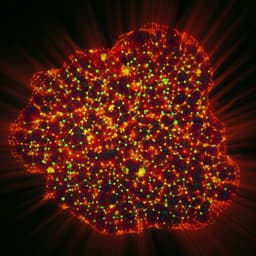
Chemistry
Teaching a neural network to attach and detach electrons from molecules
R. Zubatyuk, J. S. Smith, et al.
This groundbreaking research introduces an enhanced machine learning framework, AIMNet-NSE, for accurately simulating open-shell anions and cations without the need for quantum mechanical calculations. Conducted by Roman Zubatyuk, Justin S. Smith, Benjamin T. Nebgen, Sergei Tretiak, and Olexandr Isayev, it offers insights into ionization potential and electron affinity, paving the way for innovative chemical reactivity modeling.
~3 min • Beginner • English
Introduction
The study addresses how to accurately and efficiently model electron attachment (EA) and detachment (IP) and spin-polarized charge distributions in molecules using deep neural network potentials. Standard DFT methods scale cubically with system size, limiting applicability to larger systems and long time scales, while many existing ML potentials are trained only for neutral or closed-shell species and rely on local geometric descriptors that struggle with intensive, non-local electronic properties. The central question is whether information from multiple molecular charge and spin states can be fused into a single ML model to improve accuracy, generality, and data efficiency. The authors propose joint modeling via multitask learning and data fusion to learn energies and spin-polarized atomic charges across neutral, cationic, and anionic species, enabling direct computation of conceptual DFT reactivity descriptors (e.g., electronegativity, hardness, Fukui functions) without additional QM calculations.
Literature Review
The paper reviews ML interatomic potentials and architectures such as Behler–Parrinello and derived models (ANI, TensorMol) that use symmetry functions, and message-passing architectures (HIP-NN, DTNN, SchNet, PhysNet). ANI has demonstrated high accuracy on neutral molecules with large datasets (ANI-1ccx), while AIMNet introduced learnable atomic feature vectors (AFVs), multimodal outputs, and iterative message passing to capture longer-range effects. Prior ML efforts for intensive properties and excited-state dynamics are noted, as are charge equilibration schemes (EEM, QEq, QTPIE) and ML-based charge/electrostatics methods. However, conventional geometric descriptors typically do not adapt to total charge and spin multiplicity. Conceptual DFT provides reactivity descriptors (electronegativity, hardness, Fukui functions) derivable from IP/EA, motivating models that can provide these quantities directly.
Methodology
Architecture: Four models are considered. (a) ANI uses AEV-based radial and angular symmetry functions aggregated by one-hot species encodings to predict atomic energy contributions. (b) AIMNet replaces one-hot encodings with learnable atomic feature vectors (AFVs), forms embedding vectors G, and uses a multimodal AIM layer with iterative message passing/updates across t passes: (P, A^{t+1}) = F(G, A^t). (c) AIMNet-MT is a multitask variant jointly predicting energies and spin-polarized charges for predefined charge states sharing the same representation. (d) AIMNet-NSE extends AIMNet by taking total molecular charge/spin multiplicity as input and introducing a Neural Spin-charge Equilibration (NSE) unit. NSE predicts initial spin-polarized atomic charges q̄ and weight factors f from the AIM layer and renormalizes charges to conserve specified total spin charge Q via q_i^s = q̄_i^s + f_i (Q − Σ_i q̄_i^s). The renormalized charges are injected back into AFVs for subsequent iterations, enabling explicit, self-consistent-like charge equilibration across t=3 passes.
Targets and metrics: Total energies for neutral, cation, and anion states are predicted; vertical IP and EA are computed by energy differences (IP = E_cation − E_neutral; EA = E_neutral − E_anion). Spin-polarized NBO atomic charges are learned, enabling post hoc calculation of conceptual DFT descriptors: μ = −(IP+EA)/2, η = (IP−EA)/2, ω = μ^2/(2η), and condensed Fukui functions f^+, f^−, f^0 and corresponding philicity indices ω^+, ω^−, ω^0.
Data generation: ~200k neutral molecules (≤16 heavy atoms; elements H, C, N, O, F, Si, P, S, Cl) were sampled from UniChem. For each molecule and charge state (neutral, cation, anion), a 3D conformer was generated with RDKit, optimized with GFN2-xTB, and used to fit QMDFF parameters (force constants, charges, bond orders). QMDFF-driven 500 ps NVT MD simulations with snapshots every 50 ps provided near-equilibrium geometries. For each snapshot, single-point DFT (PBE0/ma-def2-SVP) calculations were performed at the MD charge state and its neighboring charge states, yielding up to 70 DFT points per molecule. NBO-7 was used to compute spin-polarized atomic charges. Datasets: Ions-12 (6.44M structures; ≤12 heavy atoms; 45% neutral, 25% cation, 30% anion) for training/validation; Ions-16 (295k structures; 13–16 heavy atoms; 48% neutral, 24% anion, 26% cation) for testing; ChEMBL-20 (800 neutral drug-like molecules; 13–20 heavy atoms) with B97-3c energies for neutral, anion radical, and cation radical (equilibrium conformers) for external evaluation.
Training: Models were implemented in PyTorch and trained with Adam, data-parallel multi-GPU (8×V100) with effective batch size 2048, reduce-on-plateau LR schedule, converging in 400–500 epochs. Minibatches grouped molecules by atom count. AIMNet variants used t=3 iterative passes, sharing weights across passes. Loss: weighted multi-target MSE on energies and charges; for AIMNet-NSE, only the last two passes contributed to the loss due to the first pass lacking total spin charge information. Baseline ANI and AIMNet were trained separately per charge state; AIMNet-MT and AIMNet-NSE were jointly trained across states. Five-fold cross-validation produced model ensembles (ens5). Performance was assessed via RMSE on energies and derived IP/EA, and via charge RMSE; correlation metrics were reported for conceptual DFT descriptors.
Case study: For electrophilic aromatic substitution (EAS) regioselectivity, AIMNet-NSE-derived descriptors (Fukui coefficients, philicity indices, and the AIM layer vector for the query atom in the cation-radical form) were used as features in a Random Forest classifier. Performance was compared to literature methods (DFT-derived descriptors with RF, RegioSQM, WLNN).
Key Findings
- Accuracy across charge states: All AIMNet variants outperform ANI on charged species; AIMNet-NSE shows consistent, superior performance across sizes and charge states. On Ions-16 (ens5), AIMNet-NSE RMSEs (kcal/mol): cation 3.4, neutral 2.5, anion 2.6; IP 3.5, EA 3.0. On ChEMBL-20 (ens5): IP 2.7, EA 2.4.
- Intensive properties: Vertical IP and EA errors approach ~0.10 eV for optimized structures and ~0.15 eV for off-equilibrium geometries. Compared to IPEA-xTB on ChEMBL-20, AIMNet-NSE is more accurate and far faster: IPEA-xTB RMSEs vs PBE0/ma-def2-SVP are EA 4.6 and IP 10.6 kcal/mol, while AIMNet-NSE achieves EA 2.7 and IP 2.4 kcal/mol.
- Spin charges: AIMNet-NSE predicts spin-polarized atomic charges with high accuracy: RMSD ≈ 0.011 e for neutral and ≈ 0.019–0.022 e for ions (Ions-16), enabling accurate condensed reactivity indices; example 4-amino-4'-nitrobiphenyl shows correct spin-density patterns with MAE ~0.02–0.03 e on non-hydrogen atoms.
- Iterative updates: Increasing AIMNet passes t improves accuracy, with largest gains from t=1 to t=2; results converge by t=3, particularly benefiting cation predictions.
- Ensemble gains: Ensembling (ens5) provides ~0.5 kcal/mol average improvement on energy-based quantities.
- Conceptual DFT descriptors: Strong correlations for global indices (R² ≈ 0.93–0.97 for χ, η, ω). Condensed Fukui functions and philicity indices show good performance (R² ~0.79–0.87), with philicity being the most challenging.
- EAS regioselectivity: RF classifier using AIMNet-NSE descriptors attains 0.906 validation accuracy and 0.850 test accuracy, comparable to state-of-the-art, while achieving orders-of-magnitude speedup by avoiding QM calculations.
- Comparative performance: AIMNet and AIMNet-MT have larger errors for cations and vertical IPs, indicating limitations of implicit equilibration; AIMNet-NSE’s explicit charge conservation/equilibration remedies this and generalizes to larger molecules not seen in training.
Discussion
The results demonstrate that fusing information from multiple charge and spin states within a single architecture and explicitly conditioning on total charge/spin enables accurate prediction of intensive electronic properties. The AIMNet-NSE model addresses the non-locality of charged species via iterative updates and an explicit neural spin-charge equilibration that conserves total charge and adapts atomic representations to electronic state. This directly answers the research question by showing joint learning with data fusion improves accuracy and generalization compared to separate models or implicit schemes. The model’s ability to reproduce IP/EA and spin-resolved charges allows direct computation of conceptual DFT descriptors without additional training or QM, facilitating rapid reactivity analysis. Comparable or superior performance to semi-empirical methods (IPEA-xTB) with much lower computational cost underscores the model’s practical significance for high-throughput applications. The accurate transfer to larger, unseen molecules and successful EAS regioselectivity predictions illustrate the utility of learned atomic representations (AIM vectors) as rich descriptors for downstream tasks. Compared to physics-based charge equilibration (EEM/QEq/QTPIE), NSE avoids restrictive approximations yet maintains physically consistent behavior between geometry, energy, and charge distribution.
Conclusion
The work introduces AIMNet-NSE, a neural network architecture that predicts energies and spin-polarized atomic charges for arbitrary molecular charge and spin states with near chemical accuracy, enabling reliable vertical IP/EA and conceptual DFT descriptors directly from the model. Through multimodal learning, shared atomic representations, and explicit neural spin-charge equilibration, the model achieves consistent performance across charge states and molecule sizes, outperforming baseline architectures and semi-empirical methods while offering dramatic computational speedups. The framework supports downstream reactivity predictions, exemplified by competitive EAS regioselectivity results without QM. This flexible incorporation of electronic information into ML potentials is a step toward a universal neural network capable of quantitative prediction of multiple properties; future directions include expanding chemical element coverage, extending to larger systems and diverse chemistries, and integrating additional electronic observables.
Limitations
- Larger errors are observed for cation energies compared to neutral/anion in some settings; condensed philicity indices are more difficult to predict (lower R²) due to sensitivity to cation energies.
- The iterative SCF-like update lacks a formal variational convergence guarantee, though empirically converges by t=3.
- Training data were limited to molecules with up to 12 heavy atoms (for training) and elements H, C, N, O, F, Si, P, S, Cl, potentially limiting transferability to significantly larger systems or other elements/chemistries.
- Reference data rely on specific DFT levels (PBE0/ma-def2-SVP for Ions-12/16; B97-3c for ChEMBL-20), so accuracy is benchmark-dependent.
Related Publications
Explore these studies to deepen your understanding of the subject.







